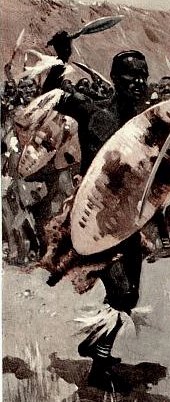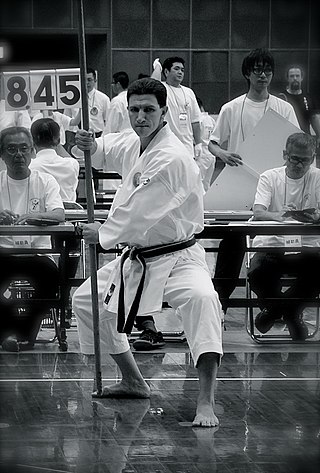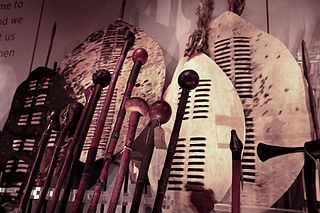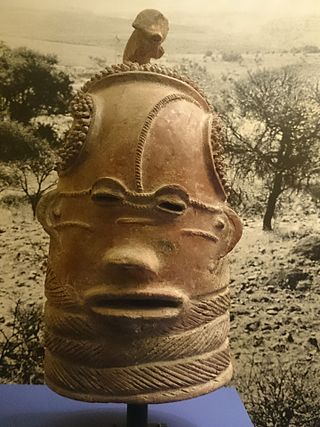
Impi is a Nguni word meaning war or combat and by association any body of men gathered for war, for example impi ya masosha is a term denoting an army. Impi were formed from regiments from amakhanda. In English impi is often used to refer to a Zulu regiment, which is called an ibutho in Zulu or the army.

Shaka kaSenzangakhona, second name Shaka Zulu and Sigidi kaSenzangakhona, was the king of the Zulu Kingdom from 1816 to 1828. One of the most influential monarchs of the Zulu, he ordered wide-reaching reforms that re-organized the military into a formidable force.

Zulu people are a Nguni ethnic group native to Southern Africa. The Zulu people are the largest ethnic group and nation in South Africa, with an estimated 10–12 million people, living mainly in the province of KwaZulu-Natal.

Arnis, also known as kali or eskrima/escrima, is the national martial art of the Philippines. The three are roughly interchangeable umbrella terms for the traditional martial arts of the Philippines, which emphasize weapon-based fighting with sticks, knives, bladed weapons, and various improvised weapons, as well as "open hand" techniques without weapons.

Gatka is a form of martial art associated primarily with the Sikhs of the Punjab and other related ethnic groups, such as Hindkowans. It is a style of stick-fighting, with wooden sticks intended to simulate swords. The Punjabi name, gatka, refers to the wooden stick used and this term might have originated as a diminutive of a Sanskrit word, gada, meaning "mace".
The Northern Ndebele people are a Nguni ethnic group native to Southern Africa. Significant populations of native speakers of the Northen Ndebele language (siNdebele) are found in Zimbabwe. There is another Northern Ndebele group found in the Limpopo province of the republic of South Africa which is not related to those in Zimbabwe but this Northern Ndebele ethnic group is related to the Southern Ndebele ethnic group through being the descendants of same ancestral kings named Musi kaMhlanga and Ndebele KaMabhudu. The Northern Ndebele people of South Africa are concentrated in the towns of Polokwane, Zebediela, Mokopane and Hamanskraal.

Okinawan Kobudō (沖縄古武道), literally "old martial way of Okinawa", is the weapon systems of Okinawan martial arts.

A knobkerrie, also spelled knobkerry, knobkierie, and knopkierie (Afrikaans), is a form of wooden club, used mainly in Southern and Eastern Africa. Typically they have a large knob at one end and can be used for throwing at animals in hunting or for clubbing an enemy's head. For the various peoples who use them, they often have marked cultural significance. Being able to carry the knobkerrie has also had a political dimension, especially in South Africa.
Indian martial arts refers to the fighting systems of the Indian subcontinent. A variety of terms are used for the English phrases "Indian martial arts", deriving from ancient sources. While they may seem to imply specific disciplines, by Classical times they were used generically for all fighting systems.

South African Bantu-speaking peoples represent the overwhelming majority ethno-racial group of South Africans. Occasionally grouped as Bantu, the term itself is derived from the English word "people", common to many of the Bantu languages. The Oxford Dictionary of South African English describes "Bantu", when used in a contemporary usage and or racial context as "obsolescent and offensive", because of its strong association with the "white minority rule" with their apartheid system, however, Bantu is used without pejorative connotations in other parts of Africa and is still used in South Africa as the group term for the language family.

Bokator is an ancient battlefield martial art used by the ancient Khmer military. It is one of the oldest existing fighting systems originating from Cambodia.
The weapon dance employs weapons—or stylized versions of weapons—traditionally used in combat in order to simulate, recall, or reenact combat or the moves of combat in the form of dance, usually for some ceremonial purpose. Such dancing is quite common to folk ritual on many parts of the world. Weapon dancing is certainly ancient; among the earliest historical references we have are those that refer to the pyrrhichios, a weapon dance in ancient Sparta, in which the dance was used as a kind of ritual training for battle.

Although the earliest evidence of martial arts goes back millennia, the true roots are difficult to reconstruct. Inherent patterns of human aggression which inspire practice of mock combat and optimization of serious close combat as cultural universals are doubtlessly inherited from the pre-human stage and were made into an "art" from the earliest emergence of that concept. Indeed, many universals of martial art are fixed by the specifics of human physiology and not dependent on a specific tradition or era.

Bajan sticklicking is the traditional form of stick fighting in Barbados. It is a stick fighting martial art that has its roots from Africa, where two participants used fire-hardened wooden sticks, varying in length as weapons and carrying out fighting techniques. This art most likely came to Barbados during the 16th century through the Trans-Atlantic Slave Trade.

The Zulu Kingdom, sometimes referred to as the Zulu Empire or the Kingdom of Zululand, was a monarchy in Southern Africa. During the 1810s, Shaka established a standing army that consolidated rival clans and built a large following which ruled a wide expanse of Southern Africa that extended along the coast of the Indian Ocean from the Tugela River in the south to the Pongola River in the north.
Arnis in popular culture reflects the impact that the Filipino martial arts of arnis/eskrima/kali have made outside of the martial arts community. The three terms are roughly interchangeable and for the purpose of convenience, the term arnis will be used throughout the article. These arts emphasize weapon-based fighting with sticks, blades, improvised weapons and hand-to-hand fighting which is formally known as Mano Mano or Pangamut. Because of this training with live weapons, elements of arnis have made an impact in film, video games, television, and comic books. Arnis is often used to train actors and stuntmen how to handle similar weapons for use in movies.

Indonesian martial arts includes a variety of fighting systems native to or developed in the archipelago of Indonesia, both the age-old traditional arts, and the more recently developed hybrid combatives. In the Indonesian language the term bela-diri is used to mean martial art, and in essence the Indonesian fighting arts are meant as one's defence against perceived threat and assault. Other than physical training, they often include spiritual aspects to cultivate inner strength, inner peace and higher psychological ends.

A Nguni shield is a traditional, pointed oval-shaped, ox or cowhide shield which is used by various ethnic groups among the Nguni people of southern Africa. Currently it is used by diviners or for ceremonial and symbolic purposes, and many are produced for the tourist market. A cow-hide shield is known as isihlangu, ihawu or ingubha in Zulu, and ikhaka or ikhawu in Xhosa.

Caci is a form of fighting with a whip or stick. It appears to be indigenous to Flores in East Nusa Tenggara, but it is also practiced in neighboring islands of Bali and Lombok, Indonesia. The art is sometimes called cacing or ende in Flores, and larik or kebat in Riung, while in Balinese it is known as ende.
Kandeka was a martial art tradition of Kunene people in Angola, and could refer to stick-fighting, slapboxing, or a war dance. According to Desch-Obi, primary among these was stick fighting.














